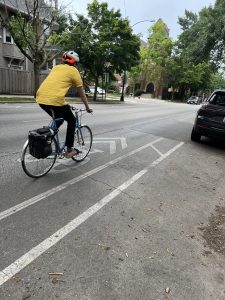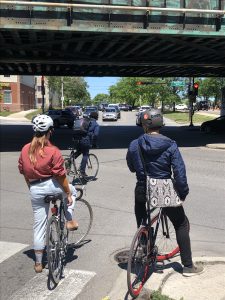When biking in Chicago, at times it feels as if one is risking life and limb just to commute from one place to another. The statistics seem to bear out that riding a bike not only feels dangerous but actually is dangerous. From June 2023 to August 2023 there were 819 bike crashes with 75 of these leading to serious injuries according to CDOT. Everyone who bikes on a regular basis in Chicago has stories of being involved in crashes with motorists or close calls. The bicycle injury lawyers of Zneimer & Zneimer P.C. have had many clients that have been injured in bicycle accidents where the motorists are simply not keeping a look-out for bicyclists, either when making a right turn, when opening a car door or when making a left turn in an intersection.
Chicago has made a concerted effort in recent years to improve the infrastructure for bicyclists in recent years, adding 400 miles of bike-ways between 2018 and 2022. Though that sounds like a lot, the reality is the vast majority of new bike-way lanes are simply painted on the roadway and offer little protection to bicyclists who are essentially still out in the traffic.
In Chicago, several intersections are notoriously dangerous for bicyclists due to a combination of heavy traffic, poor infrastructure, and the presence of multiple road users. Here are some of the most hazardous intersections and the reasons why they are considered risky:
- Milwaukee Avenue between North Avenue and Division Street: This area is high traffic with car, truck and bicycle traffic. The road lacks a uniform system of bike lanes, forcing cyclists to share the road with cars, which can lead to frequent accidents. High traffic volume and multiple intersecting roads increase the likelihood of crashes between bikes and motor vehicles.
- North, Damen, and Milwaukee in Wicker Park: This six-point intersection is big, confusing, and congested, making it difficult for cyclists to navigate safely. This is a high traffic area, packed with pedestrians and cyclists, and the lack of clear bike lanes makes the risk of accidents more likely.
- Clark Street between Racine and Fullerton Avenues: Similar to Milwaukee Avenue, this section of Clark Street sees heavy traffic and only has sporadic bike lanes. The high density of traffic, the high activity level, and frequent intersections create a hazardous environment for cyclists.
- Lincoln and Clark: This intersection is particularly dangerous due to its unusual diagonal configuration which is likely to cause confusion and the absence of adequate bike lanes. The heavy traffic flow and complex road layout make it challenging for cyclists to maneuver safely.
- Irving Park, Cicero, and Milwaukee (Six Corners): A very congested area, this intersection is challenging for all road users, especially cyclists. The mix of many entrances and exits to shopping areas, the many traffic signals, and numerous intersecting streets make the area particularly dangerous.
These intersections are dangerous because Chicago transportation infrastructure was made primarily for cars and there are few protected bike lanes. Cyclists in high congestion areas often have to ride through areas with drivers aggressively switching lanes, unclear traffic signals, and blocked visibility from the volume of traffic. It is smart for cyclists to wear high visibility clothing and to drive defensively and not assume that motorists can see them.
If you are injured in a bicycle accident, it is important to consult with a personal injury lawyer to ensure that your rights are protected. The experienced bicycle injury lawyers of Zneimer & Zneimer P.C. will provide you with a free consultation. We are conveniently located at 4141 N. Western Ave., Chicago, IL.
 Chicago Accident Lawyer Blog
Chicago Accident Lawyer Blog



